Biological and agricultural engineering associate professor Stavros Vougioukas is leading two new research projects to mechanize the orchard and pick fruit more effectively.
The first project, which received $1.2 million from the National Science Foundation’s Robotics Initiative and National Institute of Food and Agriculture (NIFA), aims to build a machine that can find and pick fruit quickly and effectively, especially when there is thick tree foliage in the way. The second project, which received $400,000 from NIFA, is focused on developing a shake-and-catch harvesting system for soft fruits to prevent fall damage.
Both projects aim to bring machines into the orchard when the necessary number of human workers are unavailable due to labor supply, costs or public health measures.
“Finding labor to harvest orchards at a large scale, and only for a limited amount of time is challenging, so our food supply depends on having technologies that will either help people harvest faster or provide harvesting alternatives for some crops when labor is unavailable,” said Vougioukas.
Harvesting Tree Fruit with Vision-Guided Robotic Arms
Automating fruit picking is a huge challenge. Fruits comes in different maturities, shapes and sizes and can be hidden behind leaves and branches. While it’s easy for a human to quickly find and gently pick fruit under these conditions, this is much more difficult for a robot and a significant technical challenge.
 Vougioukas' team will be using an existing robotic platform, shown above, for their fruit picking arm design. Photo courtesy of Stavros Vougioukas
Vougioukas' team will be using an existing robotic platform, shown above, for their fruit picking arm design. Photo courtesy of Stavros Vougioukas
To solve this, Vougioukas’ proposal is a design that combines many robotic arms, multiple cameras connected to an advanced fruit detection system powered by machine learning, and an air blowing device. The device will blow leaves and branches out of the way to make it easier to see the fruit. The cameras then send data to the neural networks, which detect the fruit, assess its location and assign and schedule one of the arms to pick it.
“This is an operations research problem that’s very common in manufacturing and logistics,” he explained. “It’s like when Uber has multiple requests for service. The software has to decide which Uber goes to which customer or, in our case, which arm is going to pick which fruit, when, and in what sequence.”
For more information: bae.ucdavis.edu
